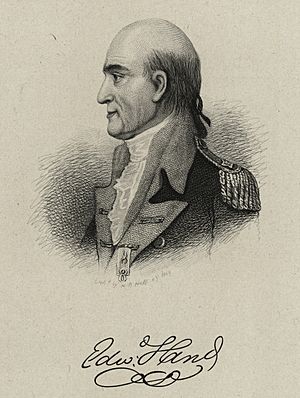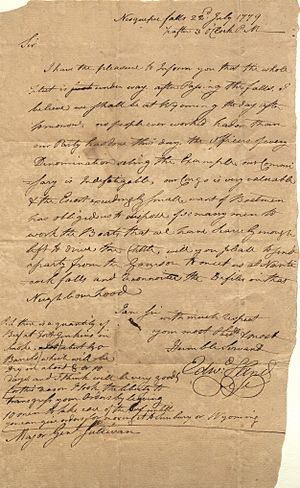Edward Hand facts for kids
Quick facts for kids
Edward Hand
|
|
|---|---|
 |
|
| Born | 31 December 1744 Clyduff, King's County, Ireland |
| Died | 3 September 1802 (aged 57) Rock Ford, Lancaster, Pennsylvania |
| Buried |
St. James's Episcopal Cemetery
Lancaster, Pennsylvania |
| Allegiance | |
| Service/branch | |
| Rank | Major General |
| Unit | Royal Irish Regiment |
| Commands held | 1st Pennsylvania Regiment |
| Battles/wars | Siege of Yorktown |
Edward Hand (born December 31, 1744 – died September 3, 1802) was an important person from Ireland. He was a doctor, a soldier, and a politician. He fought in the Continental Army during the American Revolutionary War. He became a general and later worked in the government of Pennsylvania.
Contents
Early Life and Military Start
Edward Hand was born in Clyduff, a place in what is now County Offaly, Ireland. This was on December 31, 1744. He studied medicine at Trinity College Dublin and became a doctor.
In 1767, Hand joined the 18th (Royal Irish) Regiment of Foot as a Surgeon's Mate. He sailed to Philadelphia with his regiment. Later, in 1772, he became an ensign, which is a junior officer rank.
His regiment marched to Fort Pitt in Pennsylvania. This fort was located where the Ohio River begins. In 1774, Hand returned to Philadelphia and left the British Army.
Life in Pennsylvania
After leaving the army, Hand moved to Lancaster, Pennsylvania. He started his own medical practice there. On March 13, 1775, he married Katherine Ewing.
Lancaster was a place where many Irish and Scots-Irish people had settled. Hand became very active in the community. He helped create the Lancaster County militia, called the Associators. This group was formed by colonists to protect themselves.
Hand was also a Freemason, belonging to a special military lodge.
Serving in the American Revolution
When the American Revolutionary War began, Edward Hand joined the Continental Army. This was the army of the American colonies fighting for independence. He started as a lieutenant colonel in the 1st Pennsylvania Regiment in 1775.
Rising Through the Ranks
In 1776, Hand was promoted to colonel. He was given command of the 1st Continental Regiment. A year later, in March 1777, he became a brigadier general.
He served as the commander of Fort Pitt again. Here, he fought against British loyalists and their Native American allies. After more than two years, he was called back to join Major General La Fayette's division. He commanded a brigade there.
Frontier Campaigns
In 1778, Hand was involved in military actions against Native American groups. He was trying to protect settlers in the Ohio Country. It was difficult to tell which groups were allied with the British and which were neutral.
Hand's experience on the frontier made him a good choice for a campaign against the Iroquois. This was called the Sullivan-Clinton Iroquois Expedition in 1779. It took place in New York. Edward Hand led the Third Brigade, which was the "Light Corps" of the army. His brigade was the first group to move forward. Officers' journals from the expedition show that Hand played a big part in its success.
Later War Service
After the Iroquois campaign, Hand was appointed Adjutant General of the Continental Army. This meant he was in charge of managing the army's records and orders. He served in this role during the important Siege of Yorktown in 1781. This siege was a major victory for the Americans.
In September 1783, Hand was promoted to major general. This was a special honor given for his long and excellent service. He left the army in November 1783. He was also an original member of the Society of the Cincinnati, a group for officers who served in the war.
Life After the Revolution

After the war, Edward Hand returned to Lancaster and continued his work as a doctor. He was a member of the Federalist Party and was very active in public life.
Public Service Roles
Hand held many important positions, including:
- Chief Burgess of Lancaster (a top local official)
- Presidential elector (someone who votes for the president)
- Delegate to the convention for the 1790 Pennsylvania Constitution (helped write the state's rules)
- Member of the Congress of the Confederation, from 1784 to 1785
- Member of the Pennsylvania Assembly, from 1785 to 1786
Rock Ford Plantation
Starting in 1785, Hand owned and managed Rock Ford Plantation. This was a large farm, about 177 acres, located near the Conestoga River in Lancaster. The main house, a beautiful brick mansion, is still there today. It is now a historic site that people can visit.
Like many wealthy people of his time, Edward Hand owned enslaved people who worked on his farm.
Death and Legacy
Edward Hand passed away at Rock Ford in 1802. It is thought he died from an illness like typhoid or pneumonia. He is buried in St. James's Episcopal Cemetery in Lancaster, where he had also served as a church leader.
Images for kids
-
Hand's estate, Rock Ford, in Lancaster, Pennsylvania.





